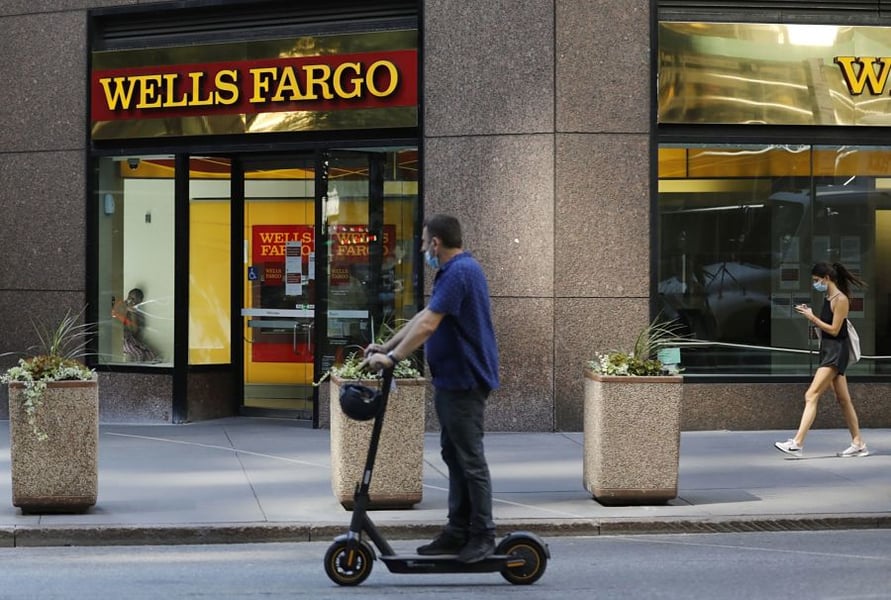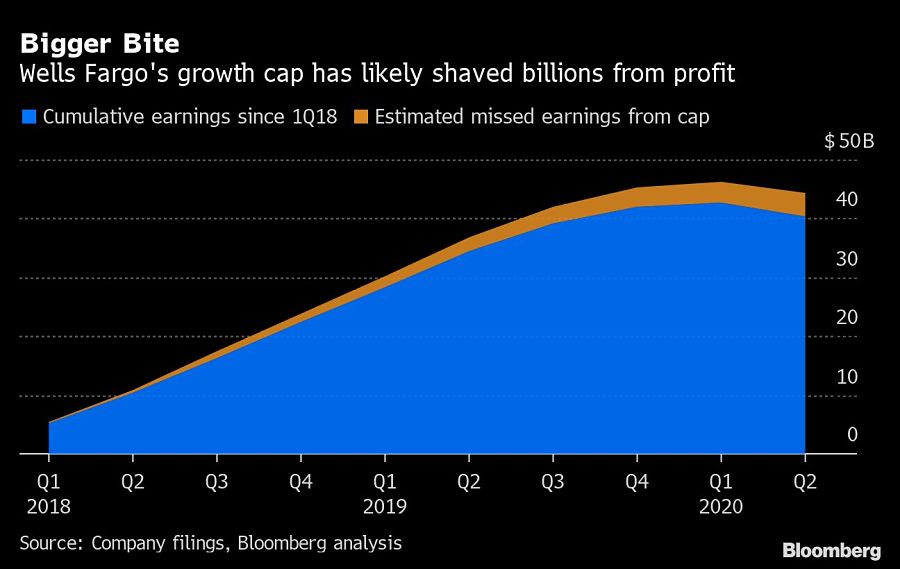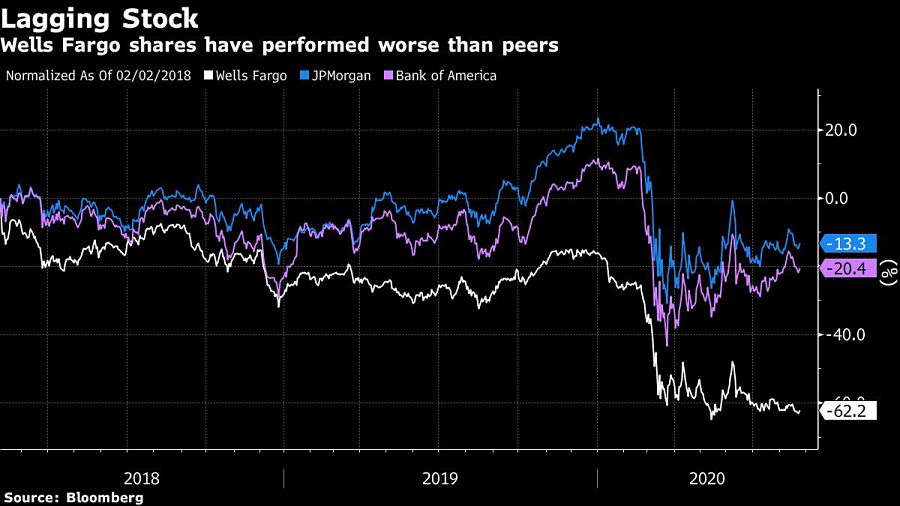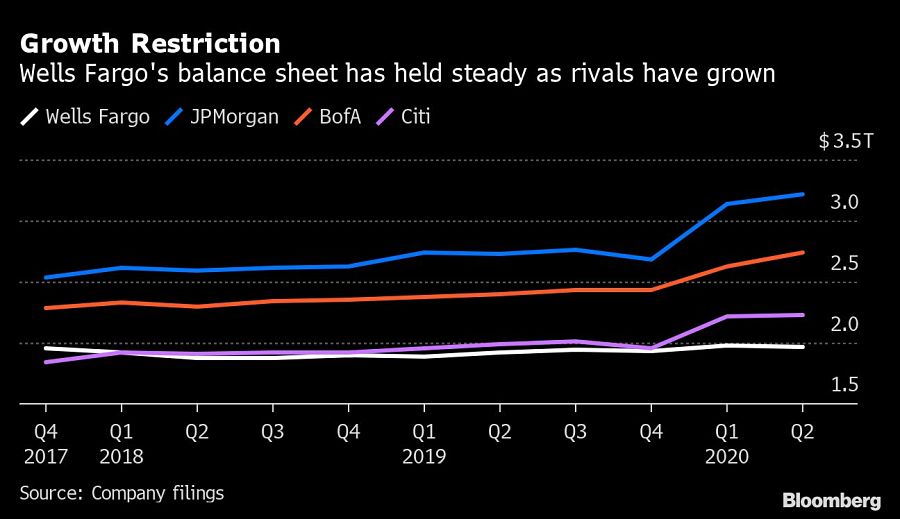

Hitting banks with multibillion-dollar fines grabs headlines, but a Federal Reserve cap on Wells Fargo & Co.’s assets is becoming the industry’s true terror.
The wonky sanction devised by the Fed in early 2018 to force Wells Fargo to address a series of scandals is turning into one of the costliest punishments ever levied by a single regulator. By one method of estimating, Wells Fargo has missed out on roughly $4 billion in profits -- and counting -- since the cap was imposed, and it’s unclear when the Fed will lift it.

That figure calculated by Bloomberg is based on how much more the bank could have earned if its assets had simply grown at the same rate and profitability as competitors. It doesn’t include the billions the lender is spending on overhauling operations, in part to get the cap lifted. Nor does it account for the longer-term impact on Wells Fargo’s franchise. As the pandemic hit, the bank struggled to meet a surge in demand for corporate financing and had to spurn some deposits, potentially sending clients to competitors.
“The old metaphor is, if organisms don’t grow they start to die,” Arthur Wilmarth, a law professor at George Washington University, said in an interview. “If it had been a one-year deal, it would’ve been inconvenient and somewhat painful but not draconian. But after 2½ years, you’d have to say it begins to look very draconian.”
To be sure, the precise cost of the Fed’s cap will never be known. Estimates based on asset growth assume Wells Fargo would have paced industry averages. It’s possible the bank would have grown more slowly than peers or earned less on assets topping off its balance sheet. Wells Fargo hasn’t specified how much it’s spending on overhauling systems. Even then, not all of it is because of the Fed.
[More: Wells Fargo resumes job cuts]
Yet in senior echelons of the financial industry, executives and their advisers are watching the asset cap closely and say it’s now seen as the harshest weapon in regulators’ arsenal, short of forcing a lender out of business entirely. Several spoke on the condition they not be named discussing sensitive regulatory matters. Some noted that, unlike a fine, Wells Fargo’s cap has put an indefinite drag on earnings, putting a spotlight on the issue quarter after quarter.
The pandemic has added to that stress, limiting the bank’s ability to finance clients and react to the changing economic environment.
Normally, the Fed’s decision to lower interest rates as the pandemic hit may have encouraged the bank to add assets such as loans to counter the impact on earnings. But “the constraints of operating under the asset cap has limited our ability to offset lower rates with balance-sheet growth,” CEO Charlie Scharf told analysts last month.
Net interest income, Wells Fargo’s biggest source of revenue, fell 18% in the second quarter. The damage might have been half that if the firm were able to expand its balance sheet, CFO John Shrewsberry estimated.
The company has lost more than $200 billion in market value since the restriction took effect, much of it this year.
“We are doing the work to satisfy the requirements of the consent order,” Wells Fargo said in a statement. “The Federal Reserve will determine when the work is done to their satisfaction. We maintain strong levels of liquidity and capital, and we are committed to using our financial strength to help support the U.S. economy and our clients while operating in compliance with the asset cap.”
A representative for the Fed declined to comment.
Just half a decade ago, many industry leaders worried more about the prospect that prosecutors might force subsidiaries to plead guilty to a crime, making it harder to do certain types of business. But since then, several lenders have proved the fallout is manageable.

Then came the Fed’s unprecedented cap. While it isn’t unusual for regulators to act alone when issuing so-called consent orders seeking reforms at banks, the Fed’s has proved to be unusually expensive. When a lot of money is at stake, banks prefer to reach so-called global settlements to end related probes simultaneously with one total price tag.
Many of the most prominent financial scandals of the past decade have culminated in a familiar template: Prosecutors often impose the biggest penalties, with individual regulators tending to get less. For example, when BNP Paribas reached a $9 billion accord with a variety of authorities in 2014 for violating U.S. sanctions on rogue nations, the largest payment to a regulator was just a fraction of the total. The same goes for Bank of America Corp.’s $17 billion settlement of probes into its handling of mortgages.
Since the Fed’s move, the Department of Justice and the Securities and Exchange Commission teamed up on a $3 billion settlement of probes into Wells Fargo’s sales practices. And the bank paid a total of $1 billion to two other regulators for consumer mistreatment.

Back when the cap was imposed, neither Fed officials nor the bank’s leaders expected the restriction to last so long, according to people familiar with their thinking. Wells Fargo executives publicly said they could imagine satisfying the requirements to get it lifted by the end of that year. They later extended that guidance twice, then outright withdrew it. Scharf has refused to provide any time line since taking over in October, cautioning that much work remains.
While consent orders tend to last years, Wells Fargo’s agreement with the Fed was designed for the asset cap to come off prior to the consent order in its entirety. The bank’s management team and board must submit plans and make certain reforms. Then once the regulator accepts them, and a third-party review is completed, the Fed may remove the growth restriction.
To this day, the Fed is awaiting a new submission after rejecting the firm’s first plan almost two years ago, according to people familiar with the matter. As Scharf assembled his new leadership team, Wells Fargo warned the Fed that it wouldn’t make an April deadline for submission. The current due date is September, which this time Wells Fargo expects to hit, the people said.

Relationships are key to our business but advisors are often slow to engage in specific activities designed to foster them.

Whichever path you go down, act now while you're still in control.

Pro-bitcoin professionals, however, say the cryptocurrency has ushered in change.

“LPL has evolved significantly over the last decade and still wants to scale up,” says one industry executive.

Survey findings from the Nationwide Retirement Institute offers pearls of planning wisdom from 60- to 65-year-olds, as well as insights into concerns.
Streamline your outreach with Aidentified's AI-driven solutions
This season’s market volatility: Positioning for rate relief, income growth and the AI rebound
